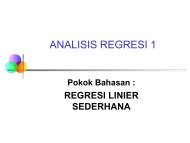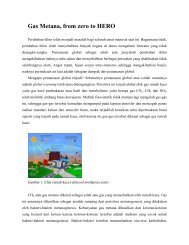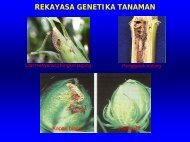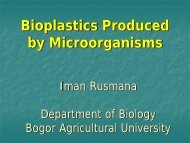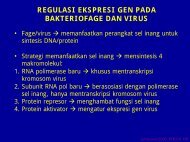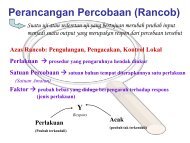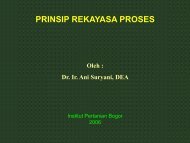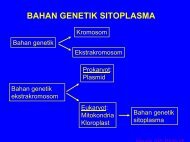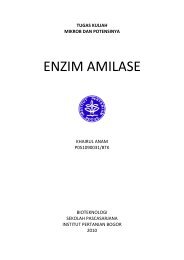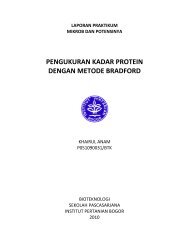Enzyme in Food & Agricultural Products
Enzyme in Food & Agricultural Products
Enzyme in Food & Agricultural Products
Create successful ePaper yourself
Turn your PDF publications into a flip-book with our unique Google optimized e-Paper software.
<strong>Enzyme</strong> <strong>in</strong> <strong>Food</strong> &<br />
<strong>Agricultural</strong> <strong>Products</strong>
Future Applications of <strong>Food</strong> <strong>Enzyme</strong>s<br />
(1)Tailor<strong>in</strong>g <strong>Enzyme</strong> Properties & Functions<br />
To <strong>in</strong>crease the efficiency of the process<br />
ultimately lower the cost of operations<br />
Example : two key enzymes <strong>in</strong>volved <strong>in</strong> corn syrup production<br />
* Gelat<strong>in</strong>ization & Complete liquiefaction by α-amylase &<br />
Ca 2+ for heat stabilization at 105 o C<br />
must be cooled<br />
to 60 o C & pH ~4.5<br />
* Saccharify<strong>in</strong>g enzyme by glucoamylase<br />
Low heat stability & acidic pH optimum<br />
Highly desirable enzymes : glucoamylase that is heat stable<br />
at liquifaction temperature<br />
Simultant process of liquifaction & saccharification
Example : Saccharify<strong>in</strong>g <strong>Enzyme</strong>s<br />
Glucoamylase : catalyze the hydrolysis of α-1,4 about 30-50<br />
times faster than the branch<strong>in</strong>g (α-1,6) l<strong>in</strong>kage.<br />
The yield ~96% but takes long time (~48 hours)<br />
It is desirable to add a debranch<strong>in</strong>g enzyme or<br />
Glucoamylase must be modified to enhance its action on (α-1,6)<br />
bonds.<br />
Dextrozyme (mixture of glucoamylase & pullulanase)<br />
Reduce the process time
Example : Lipase<br />
Transesterification of <strong>in</strong>expensive oils (e.g. palm) oil to produce<br />
substitutes for cocoa butter<br />
Melt<strong>in</strong>g properties (low and sharp melt<strong>in</strong>g po<strong>in</strong>t at 30-40 o C)<br />
Palm oil with most of its 1,3 position occupied by palmitic acid<br />
can be transesterified with stearic acid to produce CBS<br />
Desirable enzyme : High stability & high catalytic effiency lipase<br />
Example : Addition of lipase & protease to accelerate the cheeseripen<strong>in</strong>g<br />
process is of economic significance<br />
Delicate control a proper flavor profile
(2) In vivo modification of <strong>Food</strong> Quality<br />
The potential use of modification of enzymatic pathways <strong>in</strong> plants<br />
(1) Improv<strong>in</strong>g functional properties of prote<strong>in</strong> & other components<br />
more suitable for food & feed formulation & process<strong>in</strong>g<br />
e.g. high lys<strong>in</strong>e corn, golden rice<br />
(2) Tailor<strong>in</strong>g the chemical composition and physical properties of<br />
food components for value added products.<br />
e.g. high starch amylose & low moisture potato french fries<br />
absorb less oil on fry<strong>in</strong>g<br />
(3) Remov<strong>in</strong>g or reduc<strong>in</strong>g toxicants or undesirable compounds <strong>in</strong><br />
food crops to improve their nutritional value.<br />
e.g. Low HCN cassava
Amylolytic <strong>Enzyme</strong><br />
β-amylase<br />
pullulanase<br />
α-amylase
Amylolytic Activity Assay<br />
Dur<strong>in</strong>g hydrolysis, there is :<br />
1. Decrease <strong>in</strong> viscosity<br />
2. Loss <strong>in</strong> ability to give a blue color with iod<strong>in</strong>e<br />
3. An appearance of reduc<strong>in</strong>g groups<br />
4. An <strong>in</strong>crease <strong>in</strong> maltose, glucose & dextr<strong>in</strong><br />
•Depolymeration Process<br />
•Change : Degree of Polymerization (DP)<br />
Dextrose Equivalent (DE)
Optimum pH & Temperature<br />
<strong>Enzyme</strong> pH Temperature<br />
( o C)<br />
α-amylase 6.0-7.0 (mammalia)<br />
4.8-5.8 (A. oryzae)<br />
5.8-6.0 (B. subtilis)<br />
5.5-7.0 (B. licheniformis)<br />
β amylase 5.0 (wheat, malt & sweet potato)<br />
6.0 (soybean & pea)<br />
70-72<br />
90<br />
Glucoamylase 4.0-4.4 40-65
Criteria α-amylase β-amylase Glucoamylase<br />
Reduc<strong>in</strong>g group<br />
formation<br />
Fixed as equal Fixed as equal Fixed as equal<br />
Loss <strong>in</strong> viscosity Fast Slow Slow<br />
Loss <strong>in</strong> iod<strong>in</strong>e<br />
colour<br />
Maltose<br />
Production<br />
Glucose<br />
Production<br />
Relative Rate of Amylolytic Activity<br />
Fast Slow Slow<br />
Slow Fast None<br />
None None Fast
Applications of Amylase <strong>in</strong> Process<strong>in</strong>g<br />
(1)Starch Process<strong>in</strong>g<br />
as process<strong>in</strong>g aids to convert starch to starch derivatives<br />
& saccharification products.<br />
(2) Gelat<strong>in</strong>ization & liquefaction of starch<br />
(3) Saccharification of starch<br />
Glucose syrup Production : acid & enzyme catalyst<br />
The advantages of enzyme usage :<br />
- Improved the yield<br />
- Favourable economics<br />
* milder reaction condition (low T & neutral pH)<br />
reduc<strong>in</strong>g unwanted side reaction<br />
off-flavor & off-color of HMF & salts<br />
* low energy requirements<br />
* elim<strong>in</strong>ate neutralization steps.
Penyiapan beberapa gula dari pati<br />
secara enzimatis (Ka<strong>in</strong>uma, 1995)<br />
Enzim :<br />
(1) α-amilase<br />
(2) β-amilase<br />
(3) Glukoamilase<br />
(4) CGT-ase<br />
(cyclodextr<strong>in</strong><br />
glukanotransfer<br />
ase)<br />
(5) Glukosa-<br />
Fruktosa<br />
Isomerase<br />
Maltitol<br />
Hidrogenasi<br />
Maltosa<br />
Maltooligosakarida Siklodekstr<strong>in</strong><br />
Starch Syrup<br />
Starch Syrup Solid<br />
Amilase<br />
Khusus<br />
Asa<br />
m/<br />
(1)<br />
Hidrogena<br />
si<br />
Manitol<br />
PATI<br />
(2)<br />
Glukosa<br />
(5)<br />
(1) &<br />
(3)<br />
(4)<br />
(4)<br />
Hidrogena<br />
si<br />
Fruktosa Sorbitol<br />
Coupl<strong>in</strong>g sugar
Larutan Pati<br />
Pengenceran<br />
Dekstr<strong>in</strong>isasi<br />
Sakarifikasi<br />
Purifikasi<br />
Isomerisasi<br />
Pemurnian<br />
Likuifikasi<br />
Maltodekstr<strong>in</strong><br />
Sirup maltosa<br />
Sirup glukosa<br />
Sirup campuran<br />
Sirup fruktosa
Aplikasi Produk Hidrolisis Pati<br />
Produk Hidrolisis Pati DE Aplikasi<br />
Maltodekstr<strong>in</strong> 3-20 Stabilizer, thickener,<br />
filler, lem dan pasta<br />
Sirup Maltosa 48-63 Permen keras,<br />
mencegah higroskopis,<br />
bahan baku untuk fermentasi<br />
Sirup Glukosa 96-98 Soft dr<strong>in</strong>k, bahan baku untuk<br />
fermentasi<br />
Sirup Fruktosa - Industri makanan-m<strong>in</strong>uman<br />
kaleng, soft dr<strong>in</strong>k, produk susu<br />
Sirup Campuran 42-63 Soft dr<strong>in</strong>k, bahan baku <strong>in</strong>dustri<br />
pangan<br />
Sumber : Kennedy et al. (1995)
(4) Bak<strong>in</strong>g<br />
Ma<strong>in</strong> reasons for supplementation of flour with amylase<br />
• Amylase <strong>in</strong>crease the level of fermentable sugar <strong>in</strong> dough.<br />
• Amylase improve crust colour reduc<strong>in</strong>g sugars produced<br />
reacts with other components <strong>in</strong> bread to give Maillard<br />
Reaction products golden crust<br />
• The flavor of bread is improved by simple sugar and Maillard<br />
reaction products.<br />
• Gas retention properties of the dough are improved by<br />
starch modification result<strong>in</strong>g from amylase<br />
• The crumb has improved moisture retention properties<br />
• Heat stable amylase retard the stal<strong>in</strong>g of bread<br />
Amylase as anti-stal<strong>in</strong>g agents
Five general types of cellulases based<br />
on the type of reaction catalyzed<br />
1. Endo-cellulase breaks <strong>in</strong>ternal bonds to disrupt the crystall<strong>in</strong>e<br />
structure of cellulose and expose <strong>in</strong>dividual cellulose polysaccharide<br />
cha<strong>in</strong>s<br />
2. Exo-cellulase cleaves 2-4 units from the ends of the exposed cha<strong>in</strong>s<br />
produced by endocellulase, result<strong>in</strong>g <strong>in</strong> the tetrasaccharides or<br />
disaccharide such as cellobiose. There are two ma<strong>in</strong> types of exocellulases<br />
(or cellobiohydrolases, abbreviate CBH) - one type work<strong>in</strong>g<br />
processively from the reduc<strong>in</strong>g end, and one type work<strong>in</strong>g<br />
processively from the non-reduc<strong>in</strong>g end of cellulose.<br />
3. Cellobiase or beta-glucosidase hydrolyses the exo-cellulase product<br />
<strong>in</strong>to <strong>in</strong>dividual monosaccharides.<br />
4. Oxidative cellulases that depolymerize cellulose by radical reactions,<br />
as for <strong>in</strong>stance cellobiose dehydrogenase (acceptor).<br />
5. Cellulose phosphorylases that depolymerize cellulose us<strong>in</strong>g<br />
phosphates <strong>in</strong>stead of water.
The three types of reaction catalyzed by cellulases:<br />
1. Breakage of the non-covalent <strong>in</strong>teractions present <strong>in</strong> the crystall<strong>in</strong>e structure<br />
of cellulose (endo-cellulase)<br />
2. Hydrolysis of the <strong>in</strong>dividual cellulose fibers to break it <strong>in</strong>to smaller sugars<br />
(exo-cellulase)<br />
3. Hydrolysis of disaccharides and tetrasaccharides <strong>in</strong>to glucose (betaglucosidase).
Mechanisms of enzymatically hydrolysis of<br />
cellulose
Microscopic structure of cellulose fraction after<br />
164 hours hydrolysis by several bacteria isolates<br />
(Light microscope, 400 x magnificence)<br />
C4-4 C5-1<br />
C11-1<br />
Mixed Culture
Microscopic structures of cellulose<br />
before and after hydrolysis<br />
Light microscope (magnificence 400x)<br />
Light polarized microscope (magnificence 400x)
Classification of Pectic Substances<br />
1. Pectic acid pectates<br />
2. Pect<strong>in</strong>ic acids pect<strong>in</strong>ates<br />
3. Pect<strong>in</strong>s
Pect<strong>in</strong> <strong>Enzyme</strong>s<br />
1. Polygalacturonase (PG) α-1,4 glycosidic bonds<br />
- exo-PG : cleaves from non-reduc<strong>in</strong>g ends<br />
- endo-PG : attacks the substrate randomly<br />
2. Pect<strong>in</strong>esterase (PE)<br />
catalyse the hydrolysis of the methyl ester group<br />
3. Pectat Lyase (PEL)<br />
catalyse the cleavage of non-esterified galacturonate unit<br />
via α-elim<strong>in</strong>ation – endo PEL & exo-PEL<br />
substrate : pectate and low methoxyl pect<strong>in</strong><br />
4. Pect<strong>in</strong> lyase (PNL)<br />
catalyse cleavage of esterified galaturonate unit by β-elim<strong>in</strong>ation<br />
(endo-enzyme)
Activity Assay of Polygalacturonase<br />
1. The rate of decrease <strong>in</strong> viscosity of the reaction mixture<br />
2. The rate of formation of reduc<strong>in</strong>g sugars<br />
3. The decrease <strong>in</strong> optical rotation or<br />
4. The decrease <strong>in</strong> precipitability by calcium ions or non polar solvents<br />
Reduction <strong>in</strong> ~50% of viscosity<br />
Endo-PG : 3-5% of glycosidic bonds<br />
Exo-PG : 10-15% of glycosidic bonds<br />
Effects of M<strong>in</strong>erals<br />
The role of NaCl to prevent product <strong>in</strong>hibition of enzyme<br />
Ca2+ performs a role <strong>in</strong> b<strong>in</strong>d<strong>in</strong>g and or catalysis, ma<strong>in</strong>ta<strong>in</strong><strong>in</strong>g<br />
the conformation of the enzyme<br />
pH optima for most PG enzymes are pH 4.5-6.0
Activity Assay of Pect<strong>in</strong>esterase (PE)<br />
• The rate of methanol production<br />
• The Ca 2+ precipitability of the pectic acid formed<br />
Activity Assay of Pectate Lyase (PEL)<br />
Acidic (pH 4-5), neutral (pH 7-8.5) & alkal<strong>in</strong>e (pH 9-10)<br />
Activator : Ca 2+<br />
Activity of trans-elim<strong>in</strong>ases can be measured as PGs<br />
Splitt<strong>in</strong>g of the glycosidic bond by observ<strong>in</strong>g the <strong>in</strong>crease<br />
at 235 nm due to formation of the double bonds
Application <strong>in</strong> <strong>Food</strong> Process<strong>in</strong>g<br />
(1)Fruit Juice Clarification<br />
larger use of pect<strong>in</strong>ase ma<strong>in</strong>ly to deciduous juice & grape juice<br />
Effects : lower viscosity<br />
causes cloud partics to aggregate to larger units<br />
sediments are removed easily by centrifugation or<br />
ultrafiltration
(2) Treatment of pulp for Juice Extraction<br />
release of anthocyan<strong>in</strong>s of red fruits <strong>in</strong>to juice<br />
e.g. Blackcurrant juice<br />
Red w<strong>in</strong>e
( (3) Liquefaction<br />
Liquified juices are almost :<br />
- clear (papaya, cucumber)<br />
- cloudy (apples, peaches)<br />
-pulpy (carrots)<br />
(4) Maceration



